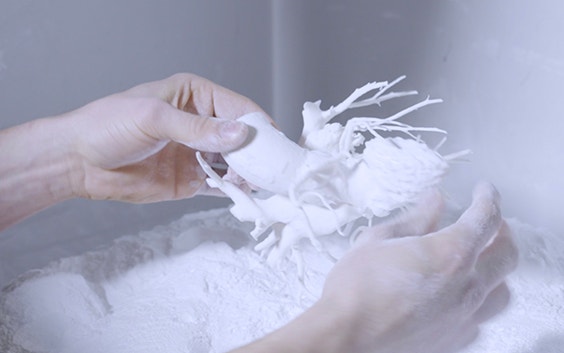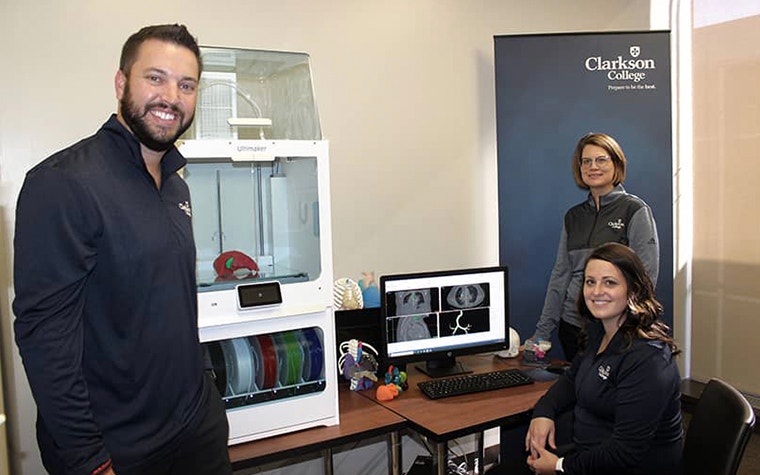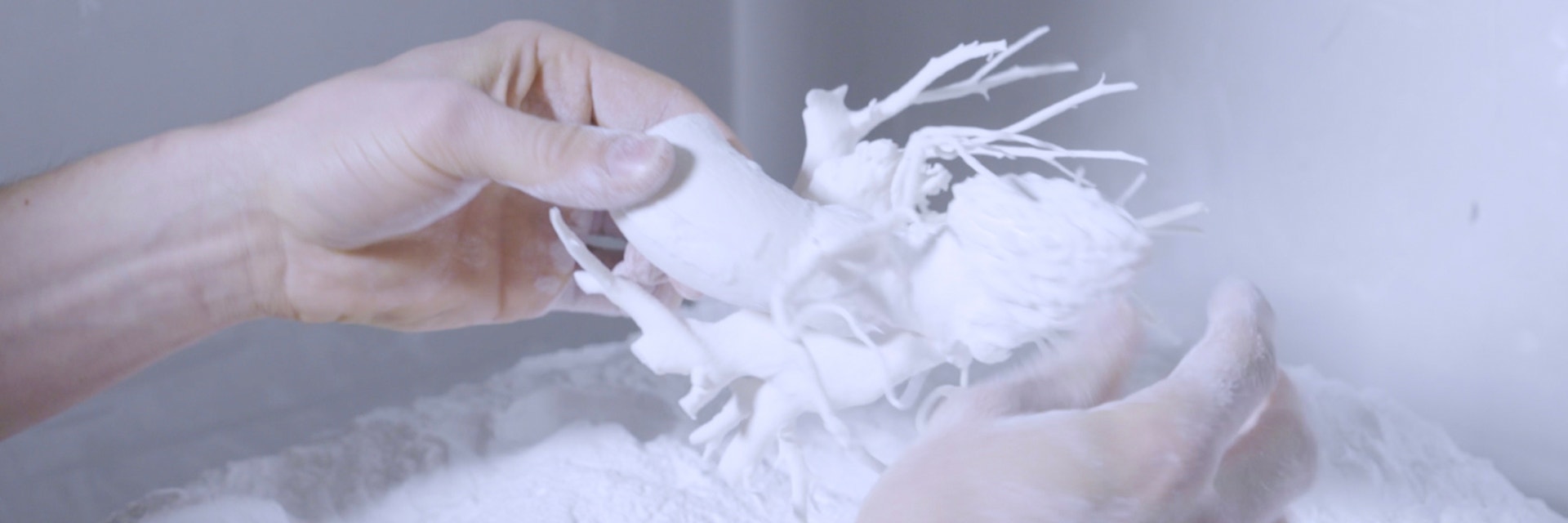CUSTOMER STORY
Clarkson College Announces First Medical 3D Printing Specialist Certificate

For over 25 years of our over 30-year history, Materialise has been working alongside healthcare practitioners to help them innovate revolutionary solutions for some of the most difficult healthcare challenges. Our Mimics software has been the foundational tool that allowed these cases to be successful through the 3D printing of anatomical models, guides, and implants that could be personalized to a patient’s unique anatomy. Now entering the next stage in this journey, Materialise is thrilled to announce that Clarkson College in Omaha, Nebraska, offers the world’s first Medical 3D Printing Specialist Certificate in collaboration with Materialise.
Bringing 3D printing to the point of care
The rise in demand for personalized healthcare has meant that 3D printing has steadily been making inroads as a valuable tool for a wide range of clinical applications. This is seen particularly in areas such as cardiology, orthopaedics, and cranio-maxillofacial surgery that are heavily reliant on medical imaging, such as CT, MRI, and X-ray, to make treatment decisions. 3D printing and its associated software offer surgeons and radiologic technologists improved diagnostic capabilities as well as greater efficiency and options when it comes to surgical planning.
With the growing body of evidence demonstrating the value of 3D printing along with greater accessibility to the technology, many hospitals are now implementing 3D printing as a point-of-care service.
Also supporting this trend are efforts to generate reimbursement opportunities for 3D printing. The American Medical Association approved new CPT codes dedicated for 3D printing applications last year in order to support further evidence gathering. In addition, the Radiological Society of North America and American College of Radiology launched a clinical data registry of which Materialise is acting as one of the founding supporters.
Urgent training for rapid growth
According to market analysts, medical 3D printing is expected to grow into an almost $2 billion industry by 2022. Now, with the COVID-19 crisis putting existing supply chains into question and opening the door for 3D printing to step up with rapid solutions, the potential for growth is expected to accelerate even more.
But with this growth comes the question of training. As 3D printing becomes more mainstream, this also means that it will require an educated workforce to perform these tasks at the point- of- care. Initiatives such as the Medical 3D Printing Specialist Certificate at Clarkson College are looking to close this gap by having more trained technologists skilled in using this technology to facilitate real-world evidence gathering to bring 3D printing into standard practice.
As Dr. Ronald Hidalgo, a radiologist in the Clarkson College program explains, “Having a way to demonstrate a level of education beyond hobbyist has shown my administration that not only do 3D labs have a place in hospitals, they also have a place in higher education. It is more than a passing phase in imaging and will help shape the future of medical imaging. Hopefully, more radiologists will jump on board and learn so that we can be the cornerstone of the new modality.”
Creating the future workforce
One of the biggest challenges in the adoption of medical 3D printing is that it is interdisciplinary, requiring skills in imaging, engineering, and even art. The learning curve to get up to speed in these additional skills is a substantial task once graduates are on the job and dealing with a full clinical workload. Realizing that the current curriculum for radiology and medical imaging professionals was not enough to prepare them for the current challenges in the workforce, Clarkson College decided to take advantage of their in-house resources and tackle the issue at the root.
“I have an interest in 3D printing and this class because of the close relationship between CT and MRI imaging techniques. I have seen first-hand how it can improve surgeries, lives, and patient care.”
— Melissa Bauer R.T. (R) (MR) (CT) (ARRT) Clarkson College Program
Clarkson College has the benefit of expert faculty who are leaders in the 3D field, so they tasked them to design a new curriculum that emphasizes a strong foundation in anatomy along with advanced segmenting and 3D post-processing concepts. The resulting certificate program is offered in collaboration with Materialise and gives students and faculty hands-on experience with Mimics software in an educational setting.
Materialise Mimics Innovation Suite is a powerful, specialized software program that can greatly increase the value of medical images as a diagnostic tool and guide to treatment. By turning 2D images into 3D models, Mimics allows clinicians to visualize a patient’s anatomy in 3D space, as well as identify specific anatomical landmarks and take measurements to create accurate 3D models for personalized device design and anatomical fit. With a more complete understanding of how a 3D-printed solution will fit and behave in the body, or the opportunity to practice surgical treatment on a personalized model, Mimics can help decrease the risk in complex cases and work to significantly improve patient outcomes.
Providing students with dedicated learning time with such state-of-the-art technology marks a fundamental shift for the future of 3D printing in medicine and sets graduates on the path to improving their employment prospects and becoming better prepared to enter the clinical environment.
Breaking new ground
“As the first certificate-based program for 3D printing in healthcare, the institution is paving the way for the future of 3D printing in medicine by addressing the most important part — the people who carry it forward,” says Gabe Linke R.T. (R) (MR) (ARRT), faculty in the Medical 3D Printing Certificate program.
Clarkson College’s Medical 3D Printing Specialist Certificate program will be giving graduates a phenomenal head start in this growing field and developing a future workforce prepared for challenges that may be best approached with non-traditional treatment modalities.


Current student Melissa Bauer R.T. (R) (MR) (CT) (ARRT) has seen already the impact a course like this can have and was motivated by this opportunity to push her clinical care skills further: “I have an interest in 3D printing and this class because of the close relationship between CT and MRI imaging techniques. I have seen first-hand how it can improve surgeries, lives, and patient care. I hope technology continues to improve to create more personalized implantable devices and organs*. Through this class, I hope to gain knowledge on the full steps required to create a 3D model and the best materials to use for each.”
The first cohort started in September 2020, and the feedback from both faculty and staff has been very positive. The program is taught virtually, and Mimics is hosted through an online platform. This inherent flexibility holds promise for the continued growth of skilled medical 3D printing professionals around the world.
*Cautionary statement on forward-looking statements
Some of the statements in this press release are "forward-looking" and are made pursuant to the safe harbor provision of the Private Securities Litigation Reform Act of 1995. These forward-looking statements include statements relating to, among other things, our planned commercialization efforts and regulatory approvals of our technologies as well as the success thereof and our research and development projects. These forward-looking statements are based upon the expectations of management under current assumptions at the time of this press release. We caution you that forward-looking statements are not guarantees of future performance and involve known and unknown risks, uncertainties and other factors that are in some cases beyond our control that may cause our actual results to differ materially from our expectations. We are providing this information as of the date of this press release and do not undertake any obligation to update any forward-looking statements contained in this presentation as a result of new information, future events or otherwise, unless we have obligations under the federal securities laws to update and disclose material developments related to previously disclosed information.
L-101673
Share on:
You might also like
Never miss a story like this. Get curated content delivered straight to your inbox.
